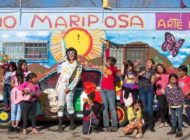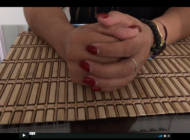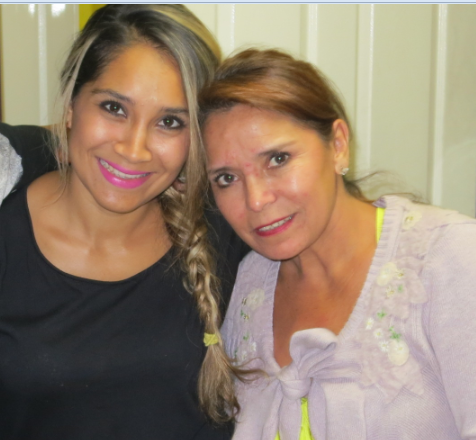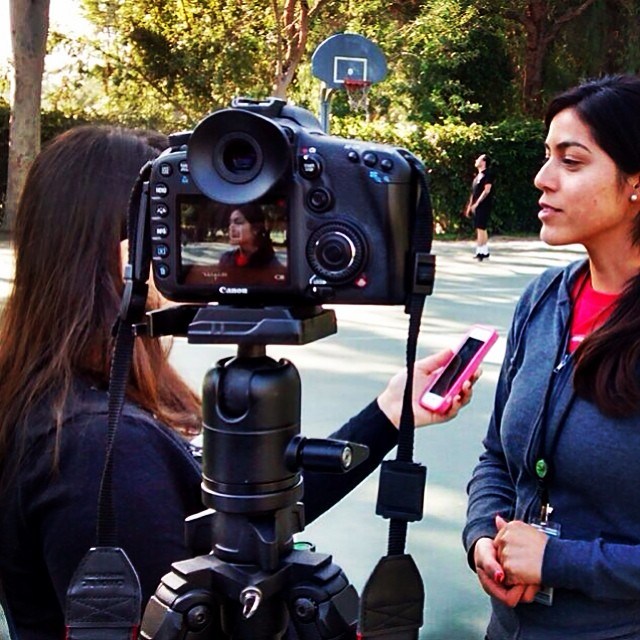Youths Learn Confidence, Self Defense From Martial Art at Sherman Oaks Club
By MORGAN MARX
EL NUEVO SOL
The scene is chaos.
Fifteen boys, ranging in age from 8 to 13, buzz about the small space. Their shrieks and laughs ricochet off the plain gray walls. In one corner, an impromptu game of soccer breaks out, a plyometric ball serving as the centerpiece. In another, two boys bounce their heads off the padded walls with increasing force.
Their parents make small talk while tapping away at cell phones. Conversations stray to the weather (“Too cold for me today”) and the school flea market. Younger siblings ride three-wheeled scooters in the foyer. The scene is familiar to any youth sport or after school activity.
The coach becomes animated, delivering a sharp whistle to get the children’s attention. He places them in order along the near wall and begins demonstrating the first warm up drill. It looks like tug of war, with each child grasping his partner’s collar and elbow.
“Remember, grip the elbow,” says the coach. “In case the guy punches you or tries to take you down.”

Instructor Joel Orozco of the Sherman Oaks Brazilian Jiu Jitsu Club explains the day's lesson to two students. Photo by Morgan Marx / ENS
It becomes clear that this isn’t basketball, gymnastics or track. The children gathered today at Street Sports in Santa Monica are practicing Brazilian Jiu Jitsu (BJJ), a form of martial arts. Based around concepts of leverage and technique, BJJ is a type of grappling focused on joint locks and blood chokes. Practiced as both self defense and sport, BJJ is rapidly becoming one of the most popular types of martial art practiced in the Southern California area.
A Yellowpages.com search turns up over 100 jiu jitsu instruction entries in the Los Angeles area alone.
Street Sports founder Renato Magno, an accomplished BJJ competitor and coach, is leading the 5 p.m. “Kids Class.” Magno has dark hair and an athletic build. His knowledge of BJJ has lead him to Hollywood, where he has assisted on television shows like “The Unit” and movie productions, including David Mamet’s BJJ film “Redbelt.” He pitches BJJ as a way for kids to enjoy physical activity.
“The important thing is that everybody has fun,” says the Brazilian-born Magno. “That nobody gets beat up.”
Just then, two boys trapped in dueling headlocks crash into the padded plywood wall separating the competition surface from the waiting area.
“Hey, what happened?” says Magno, through his heavy accent. “Slow down. Start again.”
***
Street Sports sits on a tree-lined parkway between Santa Monica College and Santa Monica Municipal Airport. A steady flow of traffic passes by small businesses and the obligatory Starbucks. An office park housing the video game company Activision stands just across the divide. The building has a slightly used look. Decals spelling out class schedules have recently been scraped from the large windows, leaving their faded outlines behind.
The inside is small and plain. The dominant decorations are mementos from Magno’s grappling career. Framed medals from various competitions cover a wall like family photos. The area behind the cash register is papered with BJJ diplomas belonging to Magno and his students. Press clippings from magazines like “Black Belt Times” and “Grappling” form a border around the mat area.
Magno moved to the United States in 1991 to teach BJJ in schools run by Jean Jacques and Carlos Machado, two legends who trace their BJJ lineage to the founders of the art. Brazilian Jiu Jitsu is based on the Japanese art of jiu jitsu, popular among samurai. A blend of judo and submission grappling, jiu jitsu migrated to Brazil in the early 20th Century as part of an exhibition of fighting styles. Carlson Gracie, the son of a Brazilian businessman, began studying under the Japanese master and introduced jiu jitsu to his family and friends.
By the 1990s, BJJ had begun to spread into the United States. Then, in 1993, a Pay Per View event dubbed The Ultimate Fighting Championship (UFC) was held as way to test which martial art was the best. The UFC was one of the first examples of mixed-martial arts (MMA) to occur in the USA. The event was won by the smallest competitor in the field, Royce Gracie, the son of Helio Gracie, Carlos’ brother and the founder of BJJ. En route to the title, Royce defeated boxers and karate fighters. Without throwing a single punch, he claimed the $50,000 prize.
Soon, BJJ schools like the Machado’s were spreading throughout the country. As the UFC rose in popularity, so too did Brazilian Jiu Jitsu. In 1998, Magno was able to open his own school, which now houses over 100 students. His website says they include competitors from age 8 to 60.
Lisa Harrison, the mother of two Street Sports BJJ students, cites the triumph of technique over size as one of the drawing points of BJJ.
“My son is tough, but he’s a little kid,” says Harrison, a Santa Monica resident. “It’s good for Aaron’s self esteem to be able to compete against larger kids.”
Aaron Harrison, aged 9, is accompanied to class by his step-brother, Ben Harrison, also 9. While Aaron is slender, with a gap-toothed grin, Ben is stocky and a few inches taller than most of the other kids. Ben, who wears a bright blue Dodgers T-shirt under his jiu jitsu uniform, was a fan of more traditional sports. Harrison didn’t expect Ben to appreciate jiu jitsu as much as baseball.
“But they both love it,” says Harrison. “Ben talked about it the entire night after their first practice.”
One of the reasons Harrison thinks her children took to the sport so quickly is the hands-on quality of BJJ. Many traditional martial arts forms, such as karate and taekwondo, focus on the precise repetition of movements and strikes. This practice, called kata, finds students working on technique in front of a mirror as opposed to with a live partner.
Brazilian Jiu Jitsu focuses almost totally on live training. While precision and repetition are keys to the sport, each practice session involves hands-on training with a partner, performing a move and experiencing live resistance.
After their warm up exercises, Magno and his assistant trainer, Rafael Carrao, begin to drill the children on a move. Today’s lesson is applying an arm bar submission hold from the mount. The students pair off, one flat on their back, the other straddling his partner’s chest. The top student (the one holding the “mount position”) grasps his opponents raised arm, and applies the hold, which places pressure on the extended elbow of his partner.
Mark Meyers’ son, Steven, responded similarly to this type of training. Steven had been involved in traditional martial arts for three years before beginning BJJ. After achieving the highest belt for his age group (a way to mark progress in martial arts, with white belts being newcomers and black belts masters), Meyers let his son choose what was next.
“He chose to continue doing martial arts, but the part he liked the best,” says Meyers, also from Santa Monica. “His favorite thing was the grappling.”
The physical grappling aspect of BJJ may be its biggest calling card, but it may also be the first aspect to worry parents and children. Though BJJ preaches control, some parents worry teaching children was is ostensibly a form of fighting. Also, like in any contact sport, injuries can and do occur.
Dr. Sohail Shayfer is a hand, elbow and shoulder surgeon associated with Encino Hospital in Encino. He has performed surgeries on practitioners of both BJJ and MMA, mainly broken arms and shoulder injuries.
“Any time you’re applying pressuring on a weaker joint, like the elbow, with the leverage exerted by your hips, the potential for injury exists,” says Shayfer.
On the surface, the training regimen for both the kids’ class and adult courses look similar. A warm up period is followed by drilling a new move. After Magno moves from station to station offering advice, praise and belt tying tips, the group moves to live sparring or free training.
Today, the students work on staying standing while grappling, a variation of the collar and sleeve warm up Magno began the class with. Magno does change his style of teaching while working with the kids’ class. He focuses on basic techniques, emphasizing balance control and posture. He does teach submissions, but reduces the amount of submissions that rely on blood chokes. He also keeps a close eye on his students as they roll, stepping in before a tap out (to signify submission) is necessary. Magno says “be careful” throughout the hour-long class, almost like a mantra. He also relies on the more experienced students to help the newcomers.
“The yellow and orange belts instruct the white belts,” he says. “Make sure no one gets hurt.”
His teaching partner, Carrao, admits that teaching a class of 8-year-olds is different. He ends class by demonstrating an acrobatic cartwheel to some of the older students.
“You have to focus on patience,” says Carrao, also a Brazilian native. “Personally, it’s easier to teach advanced students.”
For Lisa Harrison’s children, injuries seem to be the last thing on their minds. While Aaron plays keep away with a gray ball bigger than him, Ben tags along after Magno during a water break.
“When am I gonna get my next stripe,” asks Ben, pointing to a crisp white belt with two slashes of tape across its black tip. “Am I ready?”
Magno sighs and exercises patience himself.
***
In the wake of movies like “The Karate Kid,” parents enrolled children in karate and taekwondo classes at small dojos in strip malls nationwide. Spurred on the success of the UFC and MMA in general, Brazilian Jiu Jitsu could experience a boom in popularity.
Today, Street Sports BJJ offers twice weekly kids classes. Magno also offers two separate courses for “juniors,” aged 13 to 17. Similar classes are becoming the norm at BJJ schools in the area. A sign reading “Kids and Junior Classes, 5 yrs. old & up” hangs above the doors of Sherman Oaks Brazilian Jiu Jitsu Club, at the corner of Ventura and Van Nuys boulevard. Owner Chris Lisciandro, a black belt under Renato Magno, is hoping to generate the same kind of interest in children’s classes as his former teacher has experienced.
It’s October 31 and a gaggle of children ranging in size are lined up at Sherman Oaks Brazilian Jiu Jitsu Club. Parents fuss with baggy pants and brightly colored belts. As other children don Batman costumes, these kids are putting on their “gis,” the traditional BJJ uniform, in preparation for the all-ages kid’s class held on Sunday.
Instructor Joel Orozco, 34, gathers the group together. A large man with a shaved head, Orozco looks the part of a Hollywood tough guy, but has the playful demeanor of one of his students. He explains the importance of starting young with BJJ training.
“Even if some of the little kids don’t get the technique just right, they’ll develop the muscle memory and remember as they get older,” says Orozco.
Just then, a small student stops a conditioning drill to complain about a stomach ache. Orozco lets him sit to the side before admonishing his charges,
“If you’re going to train on Sunday, you have to stay away from the candy,” he says with a smile.
At once, the 13 students respond in unison.
“But it’s Halloween!”
To learn more about Brazilian Jiu Jitsu check out this photo glossary of common positions in the sport.
To find a Brazilian Jiu Jitsu school in the Los Angeles area, check out this Google map.
View Brazilian Jiu Jitsu School Locations, Los Angeles in a larger map
View Brazilian Jiu Jitsu School Locations, Los Angeles in a larger map
Tags: BJJ brazil brazilian jiu jitsu children health martial arts mixed martial arts MMA self defense Sherman Oaks


















